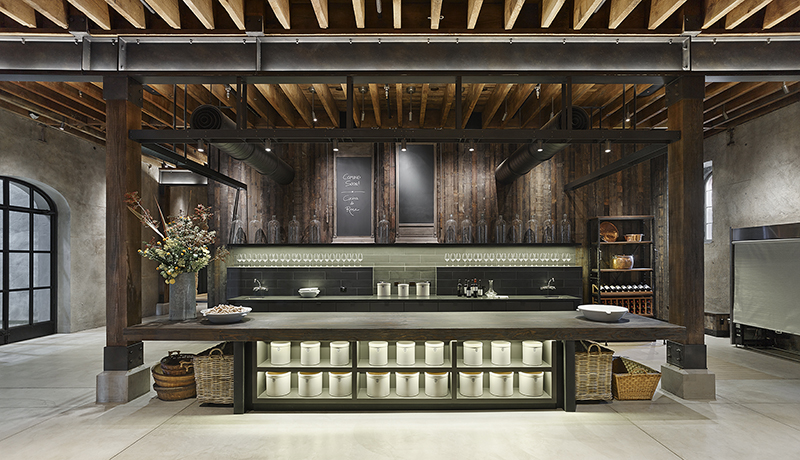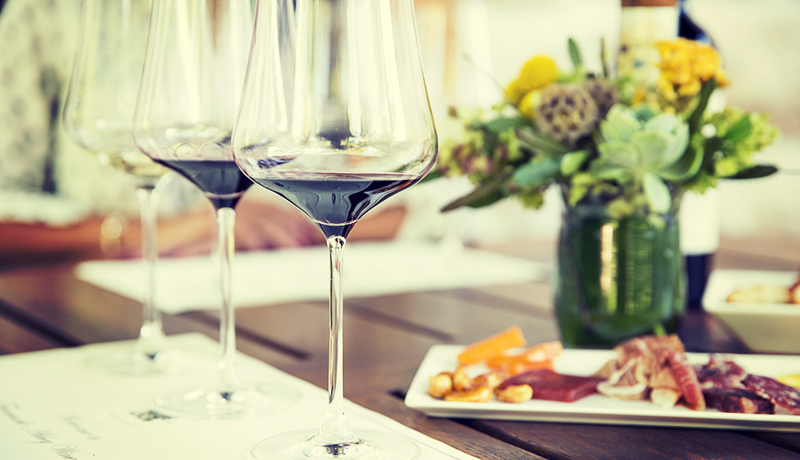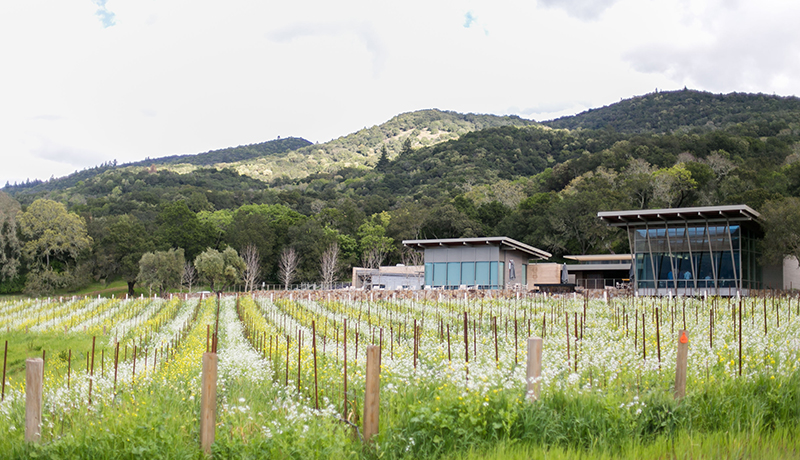

Freemark Abbey’s Experience Is Rooted In Wine Education
Photo Courtesy of Freemark Abbey
There was a simpler time when wine tasting involved wooden stands and passionate winemakers who actually poured their wine for people who happened by the vineyards. However, wine has developed into big business. Today, wine tasting isn’t just about trying some wine: It’s a cultural experience that involves culinary components, gorgeous atmospheres and, in some cases, world-renowned art.
Freemark Abbey
Wineries are no longer just tasting rooms — they offer much more. Take Freemark Abbey, for example. The winery is one of Napa’s oldest (it dates back to 1886) and is home to one of the largest collections of cabernet sauvignon in the valley. This summer it debuted a beautiful new space to host wine lovers, a hospitality center that offers a chance to taste older vintages.
“The new Freemark Abbey experience is robust and rooted in wine education,” explains Barry Dodds, the winery’s ambassador. “Set in stunning, renovated spaces that showcase the estate’s rich history, the tastings focus on the winemaking process, providing guests with fully immersive experiences. When guests arrive at Freemark Abbey, they are welcomed in the historic tasting room, where they can get an introduction to the estate’s award-winning wines with a classic tasting, or delve deeper into Freemark’s renowned cabernet sauvignons with a cabernet comparison tasting or a library tasting. Additionally, guests can take in the beautiful wine country views and enjoy cheese and charcuterie selections with a courtyard tasting.”

Charles Krug’s Tasting Room, Photo Courtesy of Charles Krug Winery
Charles Krug
Another of Napa’s pioneering wineries, Charles Krug was one of the first places to call its tasting room a hospitality center. Peter Mondavi Jr. saw the need to provide more to consumers. “The experience we offer goes far beyond tasting a flight of fantastic wines,” says Mondavi Jr. “We surround our guests with an ambience of incredible history, since we are the oldest winery in Napa Valley. From there, with our warm and friendly staff, we entertain and educate our visitors with stories of our founder, Charles Krug, and of my family with our 70-plus years at the helm of this winery.”
Old and new blend seamlessly at the modern facility, which has high, exposed wooden ceilings and plenty of room for lounging. On weekends, a portable pizza oven holds court on Charles Krug’s large lawn, and vineyard visitors are encouraged to order a pie to pair with their wine.
How else do they offer more? Mondavi puts it best: “It may be a selfie in front of ‘Big Red,’ our sole surviving redwood tank from the 1940s that was featured in two Hollywood films. It may also be the view of our Family Reserve Barrel Room from our contemporary glass elevator, which takes guests to the Redwood Loft, where they can inspect Charles Krug’s original cider press of 1858 that revolutionized winemaking of the era. Guests also have the opportunity to peruse the family’s pride and joy, our 1,700-bottle VSL (Vintage Selection Library), featuring our flagship Vintage Selection cabernets dating back to the family’s first vintage in 1944. To complete the experience, we have an espresso bar and on summer weekends offer wood-fired pizzas on the lawn.”
Lokoya
While Freemark Abbey and Charles Krug are wineries along the busy Highway 29, Spring Mountain is one of the few areas left in the valley that is largely undiscovered by tourists. That’s all going to change later this fall when Lokoya, a high-end cabernet producer under the Jackson Family umbrella, opens its new estate. While the brand has been around since 1995, winemaker Christopher Carpenter didn’t find a suitable home for the hospitality center until recently. The 77-acre property is a secluded landscape with natural springs and a heavily forested hillside.
Famed architect Howard Backen of Backen & Gillam Architects is designing the estate, and it will be a stunning structure to showcase the brand. John Taft, a principal at the architecture firm says that Lokoya will be a building that design fans will want to see. “From an architectural standpoint, the building itself is the most significant piece,” he says. “It is a historic estate with the appearance of a European castle. There is nothing like it in Napa Valley. It invokes a different place and time.”
It’s also a modern building with interesting tech aspects. “All the systems, lighting, heating, cooling, etc., have been hidden away so the structure looks sleek and seamless,” Taft explains. “This is very difficult to achieve given a stone and concrete structure, where the goal is to expose it all. In the end, we were able to accomplish both the technical and design goals, and maintain the original intent to enhance the natural beauty.”

Hamel Family Wines, Photo Courtesy of Anna Marks Photography
Hamel Family Wines
George Hamel Jr., the owner of Hamel Family Wines in Sonoma, credits his company’s hospitality center with a different way of thinking: “It’s not simply a different nomenclature; it’s a completely different way of thinking from our end and results in what we hope is a positively differentiated experience for our guests. We feel fortunate to be the stewards of an estate with such a vibrant history and distinctive terroir. [We] strive to make wine that belongs in any conversation of the finest wines, and believe that we have created an experience worthy of the site, and one that honors the quality wine we produce.”
Dawn Agnew, a longtime hospitality vet who worked for years at Restaurant Gary Danko, oversees Hamel’s program. She’s a breath of fresh air with a warm and friendly disposition to match, underscoring the concept of service that is central to the winery experience here. She greets guests with a glass of rosé, and at the end of each visit, she makes sure you leave with a cold bottle of water. When you get to your car, a cheeky badger (Hamel Family’s mascot and homage to their Wisconsin roots) floor mat sits outside the door. It’s a thoughtful final touch.
“From the moment a guest comes on property,” says Hamel, “it quickly becomes apparent that our hospitality experience is differentiated. The water and floor mat — these are simply examples representative of our hospitality philosophy — that no detail is too small, that our guests are truly guests and deserve an experience worthy of the setting, and one that honors the quality and aspirations of our wine.”
The Donum Estate
Over in Carneros at the Donum Estate, wine fans can sip sensational pinot noir while wandering the property’s extensive sculpture garden. “Those who visit Donum to taste our wines will also have the opportunity to tour the Donum Sculpture Park,” says Anne Moller-Racke, Donum Estate’s president and winegrower. “It features artists such as Ai Weiwei, Keith Haring and Fernando Botero. The sculptures add a beautiful and unexpected element to the visitor experience, dotting a classically rustic wine country landscape with globally recognized art.”
To walk by the two sentinels guarding the vineyards — Yue Minjun’s “Contemporary Terracotta Warriors” — while sipping a lush and fruity chardonnay is truly a unique experience. The estate’s new wine tasting facility, simply called the Donum House, will open in Spring 2017.
